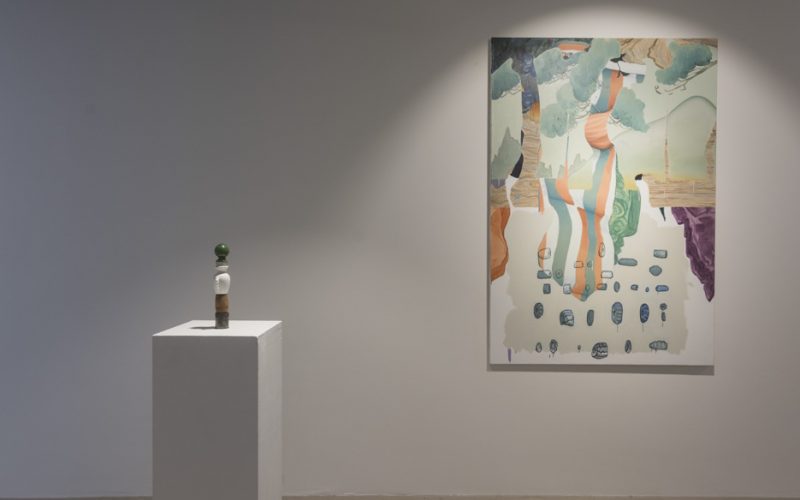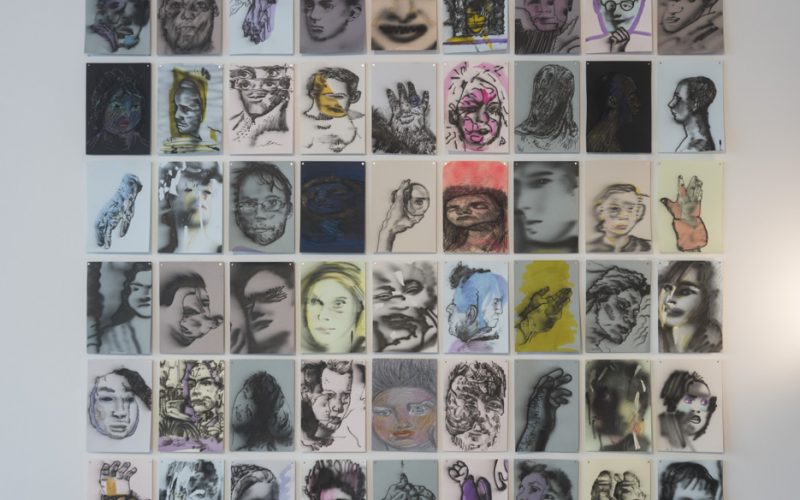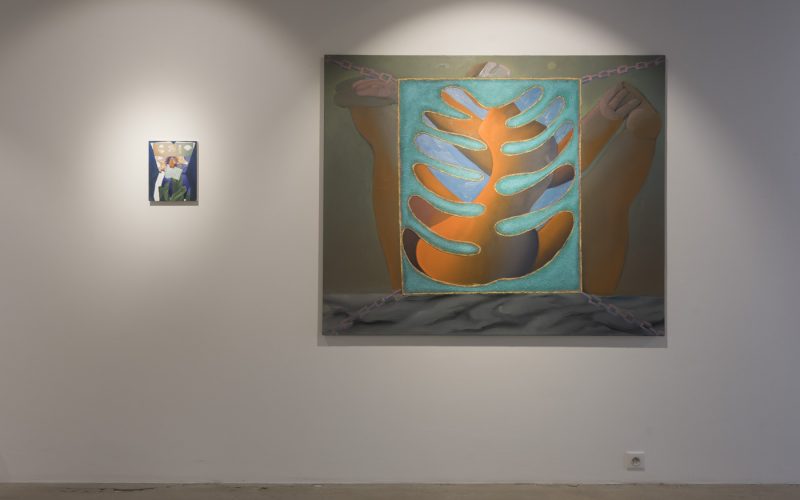23 JAN - 08 MAR 2019
ANYTHING GOES
curator: Michal Stolárik
The international curatorial project Anything Goes is a probe into the art work of the young generation of active female artists from Slovakia, the Czech Republic and Austria. The art work of Svetlana Fialová, Pavla Malinová, Nana Mandl and Titania Seidl reflect the latest trends in contemporary 2D pictures, with possible extensions into spatial art work. These artists work with traditional media (painting, drawing, collage, embroidery) and adapt them to the needs of the contemporary (world of) art. Whether working with intentional visual deformation or combining different and often uncombinable media, their works take the best from tradition while simultaneously underlining inexhaustible original techniques amidst current events.
SVETLANA FIALOVÁ (1985) SK
The latest trends in Svetlana´s work are captured by her series Prostřeno (Come Dine With Me). In 54 drawings on various coloured A4 papers, she continues to demonstrate her interest in the realm of pop-trash culture and its bizarre connections. She pays equal attention to substantively challenging and visually complicated large-scale drawings and works of “sketchbook” size that do not offer room for developing her typical visual and ideologically multi-faceted compositions. She uses this limited space for making psychological portraits of real participants in a gastronomy show that illustrates the status quo of contemporary society more than any culinary skills. She combines her critical perspective with bizarre humor and irony, demonstrating it through symbolic motifs like the mirror, her masked face or putting on a glove. She turns from general topics back to personal mythology, to stories from her own life or intimate notes in her diary, as when incorporating newly-discovered family members into a series of anonymous portraits, or reflecting personal topics and interests in the large-scale drawing Krava (The Cow).
PAVLA MALINOVÁ (1985) CZ
The monumental oil paintings of Pavla Malinová represent an exceptional phenomenon in our region. Her distinctive visual language, continuously developed in recent years, is absent in works by other contemporary artists. Her work appears to oscillate constantly between two contradicting positions – alternations of figural works with abstraction, blurred motifs competing with concrete symbols and organic shapes contrasting with geometrical. On the one hand the scenes are heavy – almost physically material. On the other they possess lightness, irony or humor. Pseudo-esoteric and spiritual influences are blended with those that are rough and grounded. It is as if the formal side of her works was based in modernistic pictures, but with the easily recognizable attributes of contemporary painting. The selection of art works displayed follows a line dominated by robust, almost cumbersome figures combined by simplified organic forms and geometric elements. They are based in trivial personal experiences and the artist´s genuine interest in things. It may sound like a cliché, but Malinová truly paints what she lives. She is interested in yoga (Sumo), and cannot imagine her life without swimming (as in a detail of stylized swimmers in her work Andělíček (Little Angel), dominated by a fountain´s metamorphosis into a spiritual figure) or an ironic and dramatic perspective on her own physical appearance, as in Skolióza (Scoliosis).
NANA MANDL (1991) AT
The complicated visual composition of Nana Mandl, created expressly for this exhibition, characterizes the works, conceptual thinking and formal language of this Austrian artist. Ideologically, she bases her work in an encounter of the physical and digital world, which mostly influences the younger generation. Her collages respond to this accelerated time, typified by an unrestrained flow of information combined with symptomatic visual pollution. In her own words, she feels a part of so-called Generation Remix, which has unlimited access to visual archives and media. She chooses from amongst them, combines and deconstructs them. In her collages, from the tiniest all the way to monumental billboard wallpapers, she takes visual material from blogs or advertising, inspired by fashion, pop culture and the old print media, also a using modern style of archiving in the form of computer and mobile screenshots. She steps into the compositions of “stolen” materials with her own drawings, often indistinguishable from their print antecedents, or with her hand embroidery that she might regularly purchase in any sewing shop and use as ready-mades. The intentional contrast of physical and digital work is significantly supported through cutting and subsequent sewing back together of individual parts of the canvas. She takes the encounter of high art and kitsch (as a reaction to the superficiality of our times) further through spatial objects: modern totems connecting different cultures, social strata and historical backgrounds. The lightened visual expression contrasts with the infinite layering of opinions and ideas of the contemporary patchwork society.
TITANIA SEIDL (1988) AT
Interestingly, a mere glance at Seidl´s oils on small wooden boards or traditional canvases will suffice to remind us of historical accounts from previous decades and centuries. Her collage-like paintings deceive us through their abstracting form, and only when trying to better grasp and understand her visual message do we distinguish individual details. Titania Seidl selects various historical objects, plants or anonymous apparel and draperies from her database of visual items. Trousers, blouses, gloves and other types of attire are depicted without figures. We don´t know if we are looking at a depiction of real clothing, or to whom it belongs or for whom it is designed. Seidl is also secretive about the source of historical vases and platters, combined with richly decorated sculptural items from baroque furniture. The historicizing character of the motifs and colours of the pictures contrast with the layered composition and her natural work with empty spaces. Those very elements reveal that the works were created in our times. The way Seidl builds the story of the picture can be associated with collage. She increases its depth through symbols, lyrical expressions and an atmosphere resembling surrealistic scenes. Citations and appropriations of visual materials from books and the internet combine with a playful approach and excerpts from various texts in the titles to her works.
The painter & the rectangle (how to turn a labour of love into currency)
2018, oil on canvas, 160 x 100 cm
Krava
2017, mixed media on paper, 150 x 207 cm
touching sign language / caro
2018, mixed media on wood and cotton, 12,5 x 10 cm
The cruelty of being kind
2018, oil on canvas, 30 x 24 cm
His unacknowledged craving for drama
2018, oil on canvas, 30 x 24 cm
she just smiled vaguely to cover her embarrassment
2018, oil on canvas, 30 x 24 cm
don't torture yourself with doubt
2018, oil on canvas, 24 x 18 cm
the lack of dignity in moving fast
2018, oil on wood, 24 x 18 cm
like a middle class maiden (flower still life no. 2)
2017, oil on wood, 24 x 18 cm
she wants things not for what they are, but what she imagines them to change for her
2017, oil on canvas, 24 x 18 cm
nothing is more ridiculous then the fashion of yesterday
2018, oil on wood, 24 x 18 cm
white shirt dreams of Brueghel flowers
2017, oil on wood, 24 x 18 cm
Prostřeno
2018, mixed media on paper, 29,7 x 21 cm
thumbsup
2017, mixed media on canvas, 130 x 90 cm
don't walk home alone at night, it said
Philea
2018, object, 54 x 10 x 10 cm
Donald
2018, object, 26 x 7 x 4 cm
Charlotte
2018, object, 105 x 20 x 20 cm
Sumo
2018, oil on canvas, 140 x 170 cm
Skolióza
2018, mixed media on canvas, 170 x 140 cm
Andelíček
2018, oil on canvas, 145 x 180 cm





